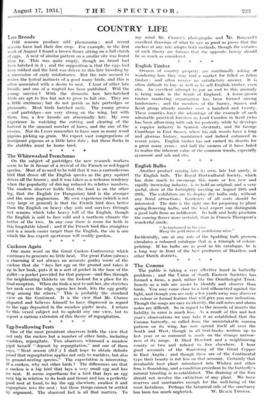The Comma The public is taking a very effective hand
in butterfly problems ; and the Union of South Eastern Societies has formed a focus, a pool, rather like the Ornithologist Trust. Insects as a rule are easier to identify and observe than birds. You may come close to a bird silhouetted against the light, and though you are only a few yards away may discover no colour or formal feature that will give you sure indication. Though the songs are easy to identify, the call notes and alarm notes are difficult. So in regard to the records of insects the liability to error is much less. As a result of this and last year's observations we may take it as established that the Comma butterfly, so called from the unmistakable comma pattern on its wing, has now spread itself all over the South and West, though in all text-books written up to last year or so comment is made on the strange narrow- ness of its range. It liked Hereford and a neighbouring county or two and refused to live elsewhere. I hear good accounts of the flourishing of the Great Copper in East Anglia; and though these are of the Continental type their beauty is not less on that account. Certainly that invaluable host plant introduced into Wicken and other fens is flourishing, and a condition precedent to the butterfly's natural breeding is re-established. The draining of the fens should not involve the Extinction of any plant. We have reserves and sanctuaries enough for the well-being of the most fastidious. Perhaps the botanical side of the sanctuary has been too much neglected. W. BEACLI THOMAS.


































 Previous page
Previous page